PowerSteering: 2016 Honda Civic Review
Introduction
Throughout the Honda Civic’s history, the car’s design and engineering has cycled between revolutionary and evolutionary. Every decade or so, Honda introduces a new Civic that serves as the segment standard for years to come. The last time a benchmark Civic arrived was for the 2006 model year. Now, the completely redesigned 2016 Honda Civic becomes the yardstick against which all compact cars will be measured.
The 2016 Civic Sedan was the first to arrive—at the end of 2015. Now, as this is written, a 2-door coupe is joining the lineup, and a 5-door hatchback is coming for the 2017 Civic lineup. The automaker also plans sporty Si and downright racy Type R variants, and likely has a green-leaning version of its new small car in the works.
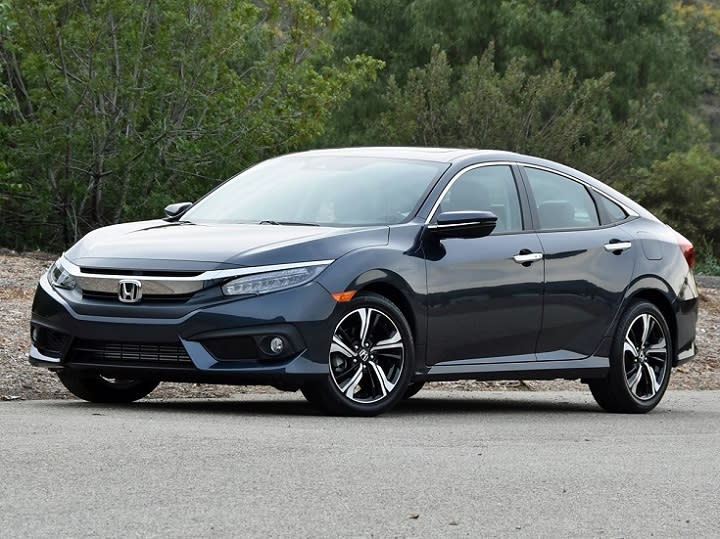
Honda offers the 2016 Civic Sedan in LX, EX, EX-T, EX-L, and Touring trim levels. For this review, our expert evaluated a Civic Touring Sedan without options. The price came to $27,335, including the $835 destination charge.
What Owners Say
Before we discuss the results of our evaluation of the new 2016 Civic, it’s helpful to understand who bought the previous version of this car and what they liked most and least about it.
According to the J.D. Power 2015 U.S. Automotive Performance, Execution and Layout (APEAL) Study,SM the Civic ranked 10th among 19 Compact Car models in terms of overall appeal, in a tie with the Buick Verano.
Buyers of the 2015 Civic are a little older and make slightly more money than the Compact Car segment average, and 52% of Civic owners are male compared with 56% of all Compact Car owners. According to the latest APEAL Study, Civic owners are less likely to value vehicles that stand out from the crowd or that offer lots of versatility, and are more likely to emphasize the importance of reliability while viewing a vehicle as just a way to get from place to place.
Among all factors in the 2015 U.S. APEAL Study, the Civic scores lower than segment average for its seats and engine, but higher in all other areas. Among individual vehicle attributes, owners cite outward visibility as a clear strength, compared with other compact cars, while at the same time identifying engine responsiveness and passing power as main opportunities for Honda to improve the Civic.
What Our Expert Says
In the sections that follow, our expert provides his own assessment of how the new 2016 Civic performs in each of the 10 categories that comprise the 2015 U.S. APEAL Study.
Exterior
Artfully sculpted and detailed, the 2016 Honda Civic looks futuristic, even polarizing. However, it won’t take long before the Civic’s popularity and the public’s familiarity with the new styling soften the appearance. Once people are accustomed to seeing this car on the road, the design is likely to age gracefully.
Interior
Inside, the new Civic’s complex and visionary design ethos continues, marking a departure from Honda’s traditional emphasis of simplicity and clarity.
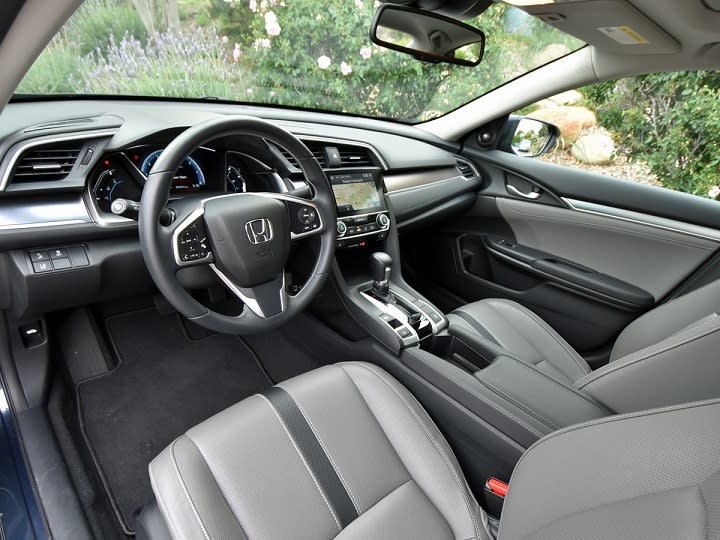
At first, the dashboard looks more conventional than the Civic’s previous 2-tiered design. However, due to its multi-layered construction; a multitude of surface tones, textures, and materials; and fancier detailing, the new control panel contributes mightily to what is a busier overall appearance.
Adding more visual flavor, the Civic Touring’s perforated leather seats display exposed stitching and contrast color stripes. Add the prominently sized center console with its partially exposed cupholder design and the Civic’s cabin is anything but clean in terms of design.
Seats
Abundant comfort awaits the Civic’s driver and passengers. The driving position is intimate, the generously bolstered seat enveloping the driver. Controls are close, and the tall, wide center console enhances the cockpit-style feeling. Taller people may not like the Civic’s snug fit, especially because the hard plastic trimming either side of the center console is unkind to legs and knees that might rest against it.
Riding in the Civic’s rear seat exacts little penalty upon adults. Plenty of legroom and foot space, combined with a comfortable seat cushion and softly padded front seat-back panels, could have some people wondering why they might need a midsized car like an Accord. While the Civic Touring test vehicle did have heated rear seats it did not offer rear air vents or a USB port, making for unhappy children on warmer days.
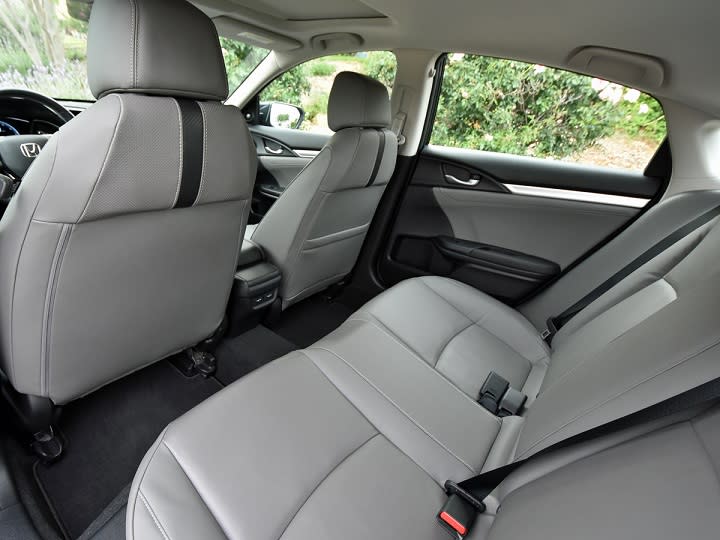
All seating positions are lower than in the previous Civic, which means people enter and exit this new car less gracefully. Also, rear-seat occupants with larger feet may struggle to extract them due to the shape of the rear floor.
Climate Control System
If you’re looking for evidence of Honda’s traditional approach to controls, check out the new Civic’s automatic climate control system. It is a model of simplicity and utility, and as a result demonstrates a level of elegance and perfection that eludes portions of the instrumentation and the infotainment system mounted above it.
Infotainment System
If you’re looking for a way to operate something, and it isn’t located on the Civic’s stalks, steering wheel, or door panel, then you’re going to need to consult the infotainment system’s tablet-style display screen.
Blessedly, Honda’s system is intuitive and easy to use if you’re familiar with a tablet computer or a smartphone. Still, it is ironic that many states have laws against using smartphones while driving, yet apparently consider it no problem at all to use something like the Civic’s infotainment system. They are essentially the same thing, except that one of them is embedded in the dashboard at the factory and uses a different operating system from the one you’re accustomed to.
That’s why the Civic is equipped with Apple CarPlay and Android Auto smartphone-projection technology. This makes the display easier to use while driving because the look and feel of the functions is familiar. Also, I found that the screen responded quickly to input, and supports swipe, pinch, and spread fingertip gestures. However, just as is true of a hand-held device, accuracy isn’t guaranteed.
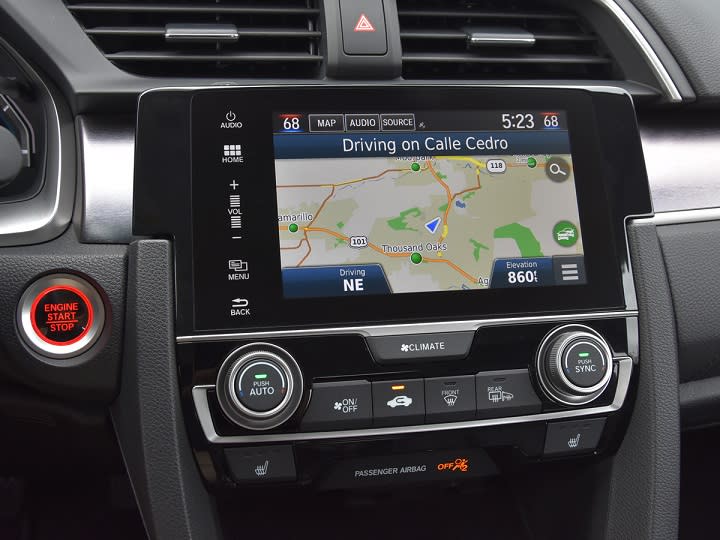
Pairing an iPhone 6 to the Civic’s Bluetooth connection was easy, but the voice-recognition system requires an upgrade to operate more like Siri. Honda also needs to offer knobs and buttons for primary radio functions, similar to how the climate controls are arranged.
For example, on multiple occasions while driving, I pressed the “Audio” screen prompt expecting to go to the radio display screen, but instead I turned the radio off. The slider volume control is also inaccurate, and tuning up and down the dial is an unnecessary hassle. Steering wheel controls resolve some of these issues, but not all.
Finally, on one occasion, I started the car and the stereo speakers emitted a disturbingly deafening buzzing and screeching noise that I could not control with the volume. It only happened that one time—while backing the car out of my driveway to park it on the street—but it was awful.
Storage and Space
Honda makes sure that Civic owners won’t have any trouble finding spots in which to stash their stuff. In addition to a generously proportioned 14.7-cu.-ft. trunk, the car’s glove box is large and the center console is commodious. Owners can configure the center storage bin in a variety of ways, too, and the Civic supplies a handy tray forward of the gear selector as well as lower-level storage area beneath it.
A 60/40 split-folding rear seat is standard for all 2016 Civics except the base LX trim level, helping to expand the car’s utility. Unfortunately, Honda does not supply an interior grab handle that you can use to swing the trunk shut, which means you’ll need to put your hand on the wet, hot, or dirty trunk lid in order to close it.
Visibility and Safety
Because the new Civic sits lower to the ground and has an aerodynamically optimized, fastback design, outward visibility is not as impressive as the previous model. That’s why the huge side mirrors and the standard reversing camera are so important to this car.
Most versions of the 2016 Civic also include Lane Watch. Using a camera mounted to the car’s right mirror, Lane Watch shows the driver what is in the right-side blind spot. The image is displayed on the infotainment system screen and works in conjunction with the turn signal or in response to a manual request for information using a button on the end of the turn signal stalk.
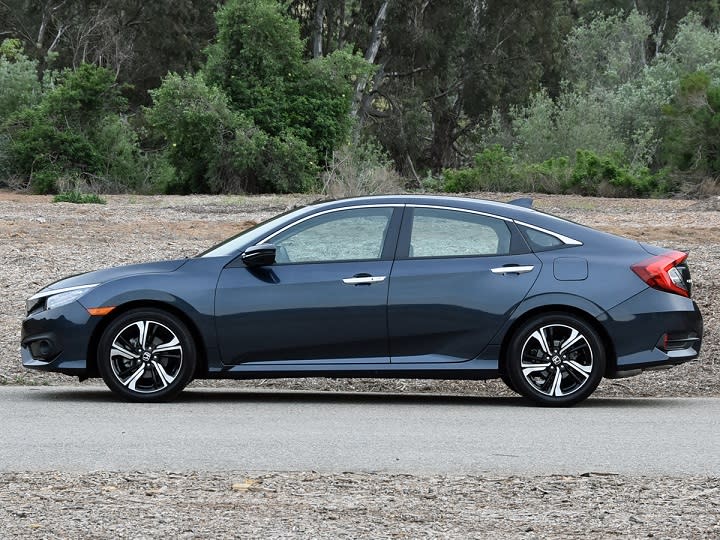
Lane Watch is an inferior solution to a traditional blind-spot monitoring system. It can warn the driver if they attempt to change lanes while another vehicle is next to the Civic, but Lane Watch only works for the right side of the car. To see in the left-side blind spot, consult the parabolic left side mirror. Furthermore, it adds a third reference point while changing lanes, increasing the driver’s mental and visual distraction.
What would be better is a traditional blind-spot monitoring system that works on both sides of the car, and which includes a rear cross-traffic alert system. Seemingly, Honda understands that Lane Watch is an inferior solution, because it uses exactly that type of technology on Acura models and on higher trim levels of the Odyssey minivan and Pilot crossover SUV.
Other than Lane Watch, Honda excels in terms of providing a safe small car. The Civic is constructed around the company’s Advanced Compatibility Engineering body structure, which is designed to disperse crash energy away from the passenger cabin. The result is a “Top Safety Pick Plus” rating from the Insurance Institute for Highway Safety (IIHS).
Honda also makes its Honda Sensing suite of driver-assistance and crash-avoidance technologies available to buyers of the new Civic as well as to buyers of all trim levels. The upgrade includes important features like forward-collision warning and automatic emergency braking, as well as a lane-departure warning system.
Personally, I found the Honda Sensing package’s Road Departure Mitigation technology useful. During a local mountain drive, while looking for a field of wild flowers in which to take a family photo, the system prevented the Civic from leaving the blacktop and rolling onto the dirt shoulder of the road.
Engine/Transmission
In the Civic LX and the Civic EX, Honda installs a new 2.0-liter 4-cylinder engine generating 158 horsepower and 138 lb.-ft. of torque. Both figures represent improvement over the previous Civic, and this engine is offered with a 6-speed manual gearbox or a continuously variable transmission (CVT).
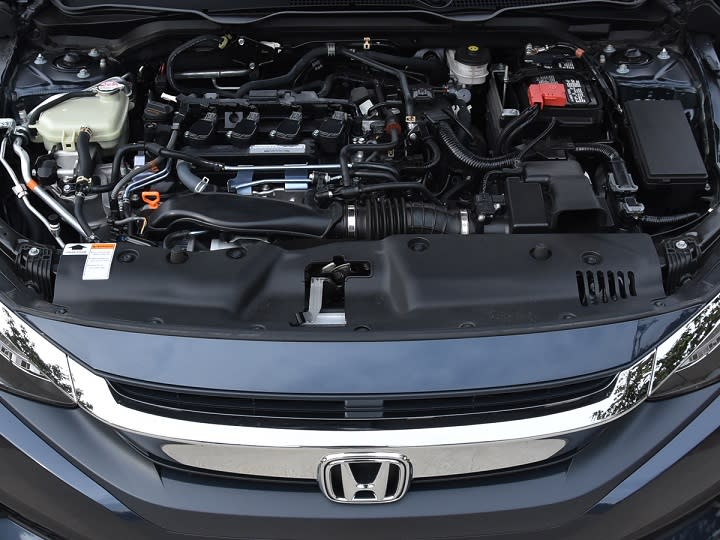
For the Civic EX-T, EX-L, and Touring trim levels, Honda employs a new, turbocharged, 1.5-liter 4-cylinder engine. It generates 174 horsepower at 6,000 rpm and 162 lb.-ft. of torque from 1,700 rpm to 5,500 rpm. Translated, this new turbocharged engine supplies a feeling of robust power across most of the rev range.
A uniquely tuned CVT helps to eliminate “turbo lag,” the common delay in off-the-line responsiveness that afflicts turbocharged engines. It also offers both Sport and Econ driving modes to help improve fuel economy.
Fuel Economy
Honda offers a manual gearbox in the Civic LX to keep the car’s base price low. With this transmission, and according to the EPA, the Civic is expected to return 27 mpg city, 40 mpg highway, and 31 mpg in combined driving.
To maximize fuel economy, get the CVT. With the standard 2.0-liter engine this transmission provides an EPA rating of 31 mpg city, 41 mpg highway, and 35 mpg in combined driving.
Those numbers match the more powerful turbocharged 1.5-liter engine in terms of city and combined ratings. On the highway, the Civic’s turbocharged engine should return 42 mpg.
While driving the Civic Touring on my test loop, and without engaging either the Econ or Sport driving modes, I averaged 34.1 mpg.
Driving Dynamics
One thing people don’t understand about Honda products until they own one is this: they’re fun to drive. For the most part, the automaker doesn’t market driving dynamics as a reason to buy one, but each Honda is developed to deliver capable handling characteristics, and this new 2016 Civic is a perfect example of the company’s approach.
From the nearly imperceptible turbo lag to the brilliant ride and handling traits, the new Civic is a delight to drive. The engine generates plenty of power, feeling robust and responsive at all times. Better yet, the CVT doesn’t sound or behave like one 90% of the time, giving the Civic natural acceleration attributes.
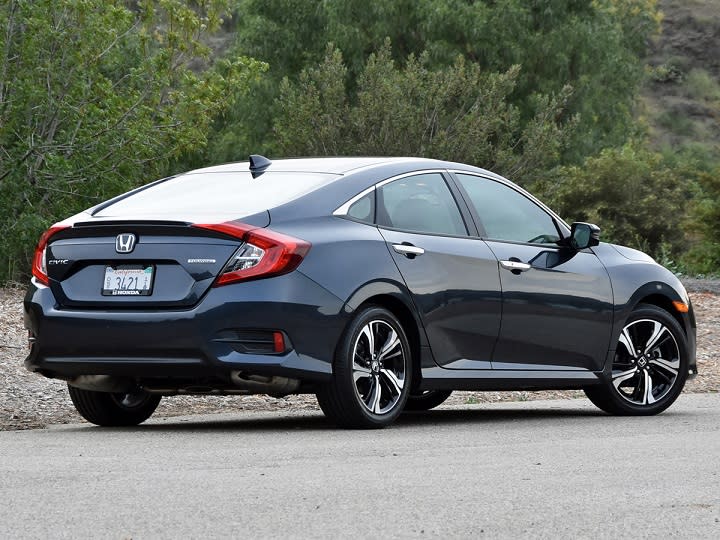
Equipped with electric steering, the Civic’s setup is perfectly tuned to provide quick and crisp response without the disconnectedness that commonly afflicts such designs. Effort levels at lower speeds are a little heavy, but otherwise there is nothing to complain about. The standard 4-wheel-disc brakes are a model of perfection, too, from how they bite to how easy it is to modulate pressure using the pedal.
Where the Civic Touring shines is in its ride and handling qualities. From behind the wheel, the driver receives clarity with regard to the road surface, but the car never feels too stiff or taut, providing a composed and compliant ride without excess body motion. Toss the car into a corner and grip is impressive. Better yet, body roll is beautifully controlled and the Civic’s new standard Agile Handling Assist technology tightens the cornering line through brake-torque vectoring.
Is the new Civic fun to drive, especially in the EX-T, EX-L, and Touring trim levels which all have the new turbocharged engine and a set of 17-in. aluminum wheels and tires? Absolutely.
Final Impressions
Honda’s new 2016 Civic takes a big step forward in terms of its emotional appeal, especially related to the design and the driving dynamics. While in the past Civic buyers may not have strongly valued such traits, Honda bakes them right into this new model’s styling, interior layout, and engineering.
Combine these characteristics with impressive fuel economy, segment-leading levels of safety, midsize-car comfort levels, and Honda’s tradition of delivering dependable vehicles, and it sure looks like the redesigned 2016 Civic represents a revolution in the compact car segment.
American Honda Motor Company supplied the vehicle used for this 2016 Honda Civic review.
For more information about our test driver and our methodology, please see our reviewer profile.
Additional Research:
Body Style:
Abstract:
The completely redesigned 2016 Honda Civic becomes the yardstick against which all compact cars will be measured.
Year:
2 016
Check this if this is NOT an Articles Listing Page:
New or Used:
New

 Yahoo Autos
Yahoo Autos 
